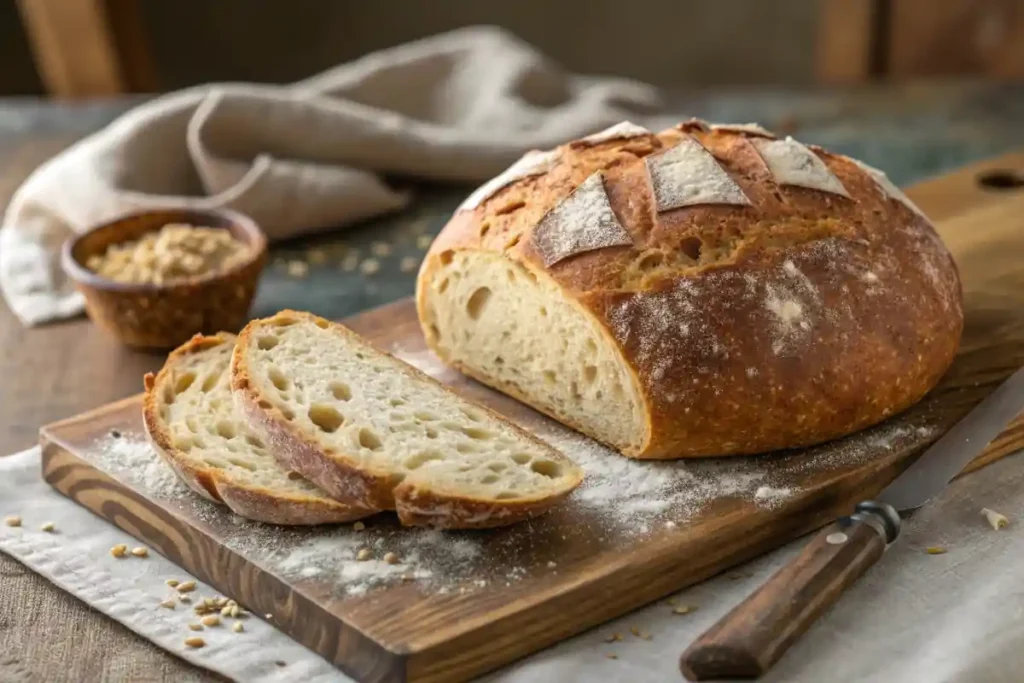Discover the joy of baking country bread at home. This simple recipe brings warmth and deliciousness to your table.
Nothing beats the aroma of freshly baked country bread. Its rustic crust and soft interior make it a timeless classic. This guide will help you bake your own loaf. Get ready to enjoy a slice of homemade goodness!
The Heart of the Hearth: Making Your Own Country Bread
Country bread evokes images of simpler times. Imagine loaves baked in wood-fired ovens, filling homes with warmth. You can recreate this experience in your own kitchen.
What Makes it Special?
Country bread, also known as pain de campagne, is celebrated for its unique qualities. Its thick crust and chewy texture set it apart. This bread often uses a mix of flours. These flours contribute to its complex flavor profile.
The appeal of country bread lies in its simplicity. It requires just a few basic ingredients. However, the process transforms these ingredients into something truly special. From mixing to proofing to baking, each step is crucial.
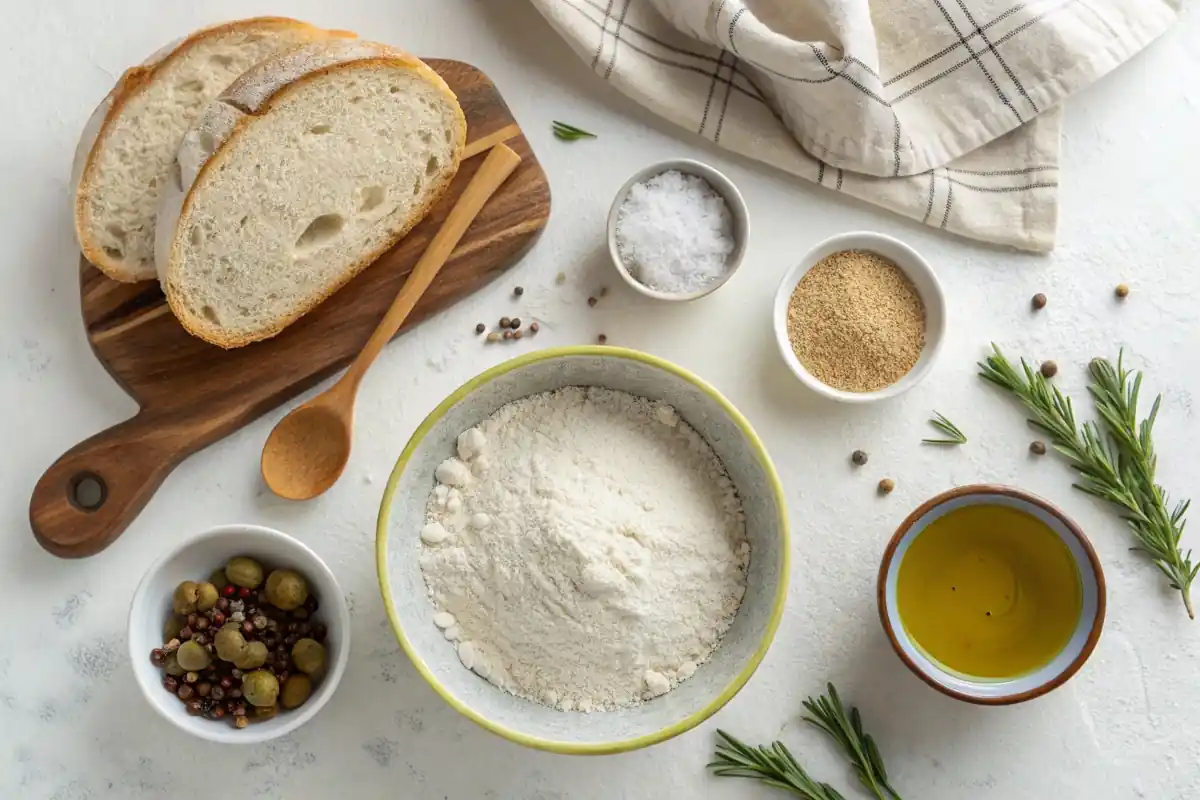
Gathering Your Simple Ingredients
To make country bread, you need simple ingredients. These ingredients work together to create a bread that is both hearty and satisfying. Here’s what you’ll need:
- All-purpose flour or bread flour
- Whole wheat flour (optional, for added flavor)
- Water
- Salt
- Yeast (active dry or instant)
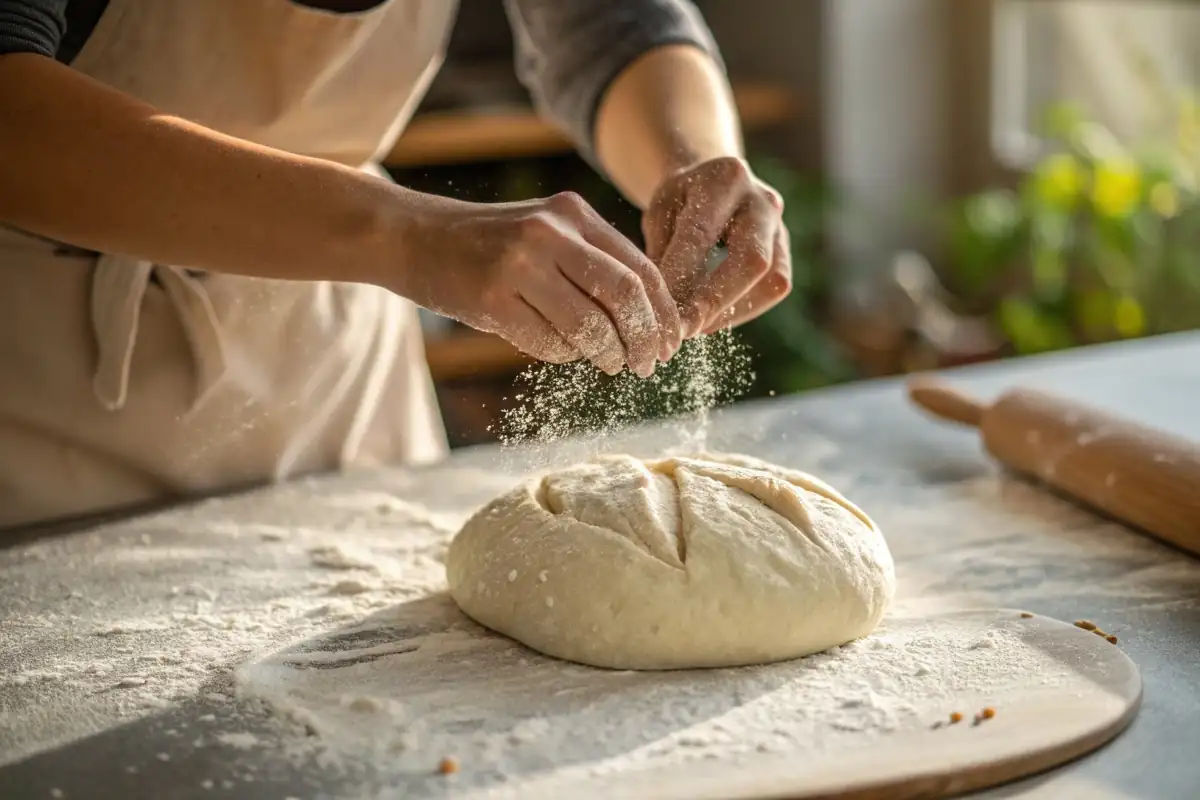
Step-by-Step Recipe for Homemade Country Bread
Follow these steps to bake your own country bread. Each step is explained simply. So, you can achieve bakery-quality results at home.
Step 1: Activating the Yeast
If using active dry yeast, dissolve it in warm water. Let it sit for 5-10 minutes until foamy. This ensures the yeast is alive and ready to work. If using instant yeast, you can add it directly to the flour.
Step 2: Mixing the Dough
In a large bowl, combine the flour, salt, and yeast mixture. Add the remaining water. Mix until a shaggy dough forms. The dough will be sticky, but that’s okay.
Step 3: First Rise (Bulk Fermentation)
Cover the bowl with plastic wrap or a damp cloth. Let the dough rise at room temperature for 2-3 hours. During this time, perform stretch and folds every 30 minutes. This helps develop the gluten structure.
- Stretch and fold: Gently stretch a portion of the dough upwards. Then, fold it over the center. Rotate the bowl and repeat until you’ve stretched and folded all sides.
Step 4: Shaping the Dough
After the first rise, gently deflate the dough. Turn it out onto a lightly floured surface. Shape it into a round or oval loaf. Be careful not to overwork the dough.
Step 5: Second Rise (Proofing)
Place the shaped loaf in a well-floured banneton basket or a bowl lined with a floured cloth. Cover it loosely. Let it rise for another 1-2 hours. The dough should almost double in size.
Step 6: Baking the Bread
Preheat your oven to 450°F (232°C) with a Dutch oven inside. Once the oven is hot, carefully remove the Dutch oven. Place the loaf inside. Score the top with a sharp knife or lame. This allows the bread to expand during baking.
Cover the Dutch oven and bake for 20 minutes. Remove the lid and bake for another 25-30 minutes. The crust should be deep golden brown. An internal temperature of 200-210°F (93-99°C) confirms it’s done.
Step 7: Cooling and Enjoying
Remove the country bread from the Dutch oven. Let it cool completely on a wire rack before slicing. This prevents a gummy interior. Enjoy your homemade country bread with butter, cheese, or your favorite toppings.
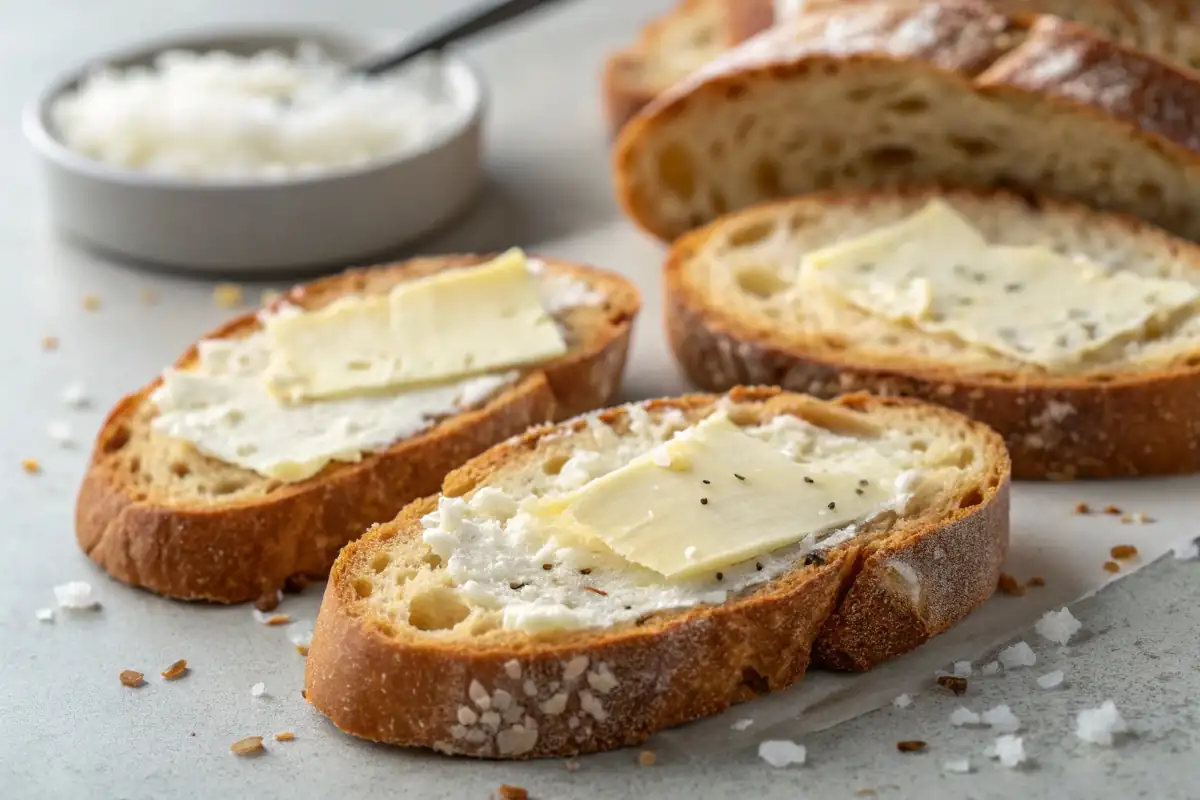
Variations and Serving Suggestions for Authentic Country Bread
Country bread is incredibly versatile. There are countless ways to enjoy it. Here are a few ideas.
Flavor Enhancements to Elevate Your Bread
Experiment with different flours. Rye flour or spelt flour can add depth. Also, try adding sunflower seeds or herbs to the dough. This adds flavor and texture.
For a truly unique loaf, consider additional ingredients. Roasted garlic cloves can infuse a savory taste. Sprinkling the dough with sesame seeds before baking adds visual appeal. Elevate your country bread by exploring these options.
Creative Ways to Serve Your Homemade Bread
- Grilled Cheese: Use thick slices of country bread for an indulgent grilled cheese sandwich.
- Bruschetta: Top toasted slices with tomatoes, garlic, and balsamic glaze.
- Soup Companion: Serve warm slices alongside your favorite soup.
- Avocado Toast: Enjoy it with mashed avocado, salt, and pepper.
- Croutons: Cube and bake for homemade croutons. They are perfect for salads.
as the Star of Simple Meals
Country bread truly shines in simple meals. Its robust flavor compliments a rich variety of dishes. It’s more than just bread; it’s an experience.
A simple salad compliments country bread perfectly. Combine fresh greens, cucumber, and a light vinaigrette. The refreshing salad balances the bread’s heartiness.
Mastering the Art: Tips and Tricks for Perfect Country Bread
Baking country bread can be challenging. However, these tips and tricks will help you succeed.
Achieving the Perfect Crust
To get a crispy crust, use a Dutch oven. The trapped steam creates a wonderful texture. Also, make sure your oven is hot enough. Scoring the dough properly is also key.
A rich, golden-brown crust is the hallmark of good country bread. Additional tips include: placing ice cubes in the oven during the first few minutes of baking (for extra steam), or brushing the loaf with an egg wash before baking (for shine and color).
Troubleshooting Common Baking Issues
- Dense bread: Make sure your yeast is active. Don’t skip the stretch and folds.
- Gummy interior: Let the bread cool completely before slicing.
- Burnt crust: Lower the oven temperature slightly. Cover the loaf with foil if needed.
Also, ensure you are balancing the ingredients correctly. Too much flour can make the dough dry. Too much water can make it too sticky. Measuring accurately is essential.
Storing Your Bread for Maximum Freshness
Store leftover country bread in a bread box or a paper bag. This will maintain its freshness. Avoid plastic bags. They can make the crust soft.
For long-term storage, consider freezing slices of country bread. Wrap them tightly in plastic wrap. Then, place them in a freezer bag. Thaw at room temperature before enjoying.
The Health Benefits of Homemade this recipe
Making your own country bread has additional benefits. You control the ingredients. This can be healthier than store-bought options.
Control Over Ingredients: A Healthier Choice
When you bake at home, you choose the ingredients. This means no artificial additives or preservatives. You can use whole grain flours for added nutrients.
Choosing organic ingredients can further elevate the quality of your country bread. Organic flour and additional organic ingredients are produced without synthetic pesticides.
Nutritional Value
Country bread can be a source of fiber and nutrients. Whole wheat flour adds fiber. Fiber aids in digestion. The fermentation process can also improve digestive health.
However, it’s essential to remember that country bread, like any bread, is compatible with a balanced diet. Pay attention to portion sizes and consider your macronutrients requirements.
Making it Fit Your Dietary Needs
You can customize country bread to fit your preferences. Use gluten-free flour if needed. Reduce the salt content. Add sunflower seeds for extra fiber.
Variations in ingredients can cater to vegetarians or those with intolerance to certain foods. Consider flax seeds for added fiber and omega-3s.
Country Bread Around the World
While the term “country bread” may seem simple, it takes on diverse forms across different regions. Let’s take a quick look at variations around the globe.
Exploring Different Regional Variations
Country bread is not just a single type of bread. Instead, it’s a category with many varieties. France has its pain de campagne, known for its rustic nature. Germany offers varieties of rye breads, robust and flavorful. Italy features regional loaves with unique textures and ingredients. Each variety reflects local baking traditions and available resources.
In Spain, you might find country bread made with olive oil. This adds a distinct Mediterranean flavor. Scandinavian countries have versions using seeds and grains.
How Baking Techniques Vary Globally
Baking techniques for country bread differ widely. Some regions rely on long fermentation processes. These processes develop complex flavors. Others use wood-fired ovens, resulting in a distinctive crust. In some areas, bakers incorporate local grains. This gives the bread a unique regional character.
In some areas, bakers use traditional stone ovens. These ovens provide even heat distribution. This contributes to a characteristic crust.
Appreciating the Bread Culture in Different Countries
Bread culture is a vital part of many societies. In some cultures, bread is a staple food, eaten daily. It’s often shared among family and friends, symbolizing unity. In others, bread is reserved for special occasions. This highlights its cultural significance.
Bread is often associated with seasonal festivals and celebrations. Different editions of country bread might feature ingredients specific to a time of year.
Elevating Your Baking: Advanced Techniques
For experienced bakers, exploring advanced techniques can elevate your country bread baking to a sophisticated level.
Mastering Sourdough
Using a sourdough starter instead of commercial yeast adds complexity. The long fermentation process develops additional flavors. It also improves digestive health. Maintaining a healthy starter is key.
Sourdough country bread often requires increased hydration. This creates an open crumb structure. The downside can be a stickier dough.
Incorporating Ancient Grains for Added Depth
Experiment with ancient grains like spelt, emmer, or einkorn. These grains offer unique flavor profiles. They also add nutrients. However, they may require adjustments to the recipe.
Ancient grains can also offer lower glycemic index options for diabetics. This may assist in achieving sustained energy levels.
Perfecting the Art of Scoring
Scoring the dough correctly is essential for a beautiful loaf. It allows the bread to expand evenly. Use a sharp lame or a serrated knife. Practice different scoring patterns for visual appeal.
Additional considerations include the depth and angle of the score. These factors affect how the loaf opens up during baking.
The Sustainable Side of Baking Country Bread
In today’s world, it’s increasingly important to consider the environmental impact of our food choices. Baking country bread can be a sustainable activity.
Sourcing Local and Organic Ingredients
Prioritize sourcing ingredients from local farmers and suppliers. This reduces your carbon footprint. It also supports your community. Choose organic options to avoid pesticides.
Choosing local ingredients also ensures freshness. Local farms often prioritize sustainable practices.
Minimizing Waste in Your Baking Process
Be mindful of ingredient waste. Use leftover country bread to make croutons or breadcrumbs. Compost any vegetable scraps.
Additional ways to minimize waste include: planning your baking schedule, properly storing ingredients, and reusing packaging.
Choosing Eco-Friendly Baking Tools
Invest in eco-friendly baking tools. Look for items made from sustainable materials. Avoid single-use plastics. Choosing recyclable or compostable parchment paper is also helpful.
Consumers are increasingly conscious of the environmental impact of their purchases. Brands are responding by offering eco-friendly editions of essential baking tools.
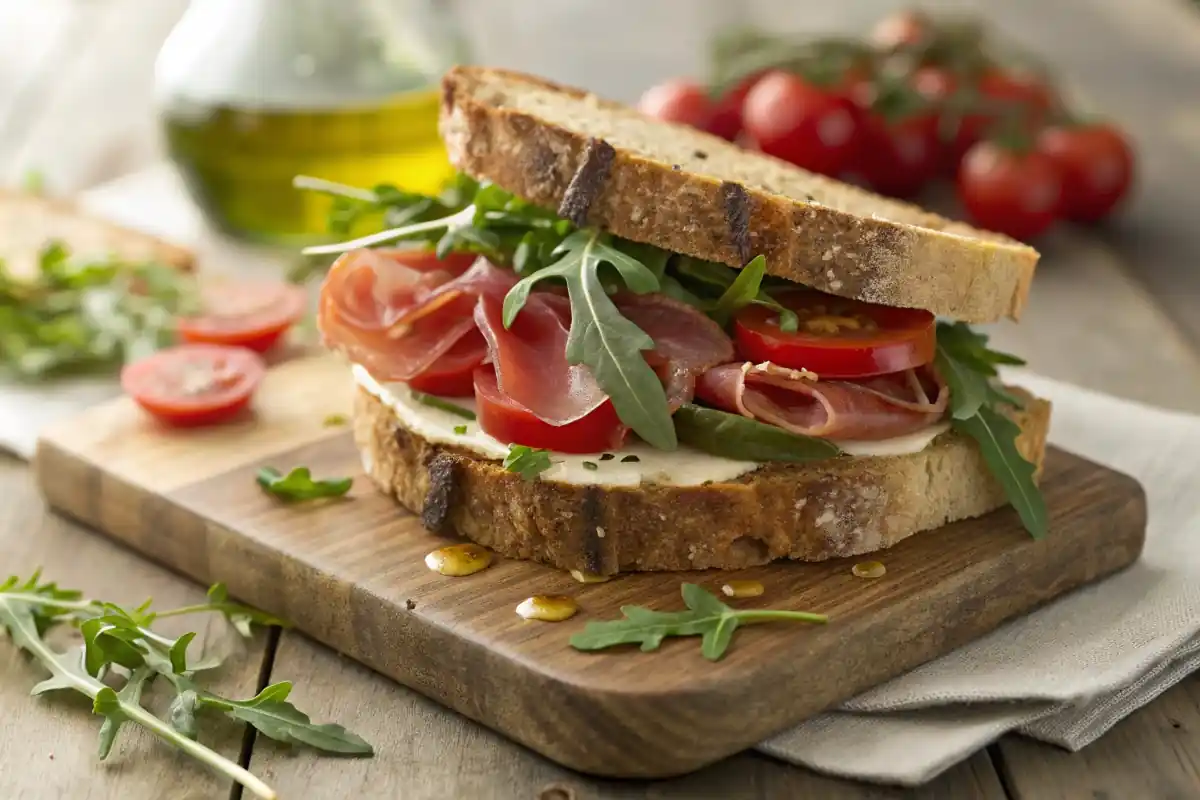
Country Bread: A Timeless Tradition
Country bread is more than just food. It’s a connection to our past. It represents simple pleasures and homemade goodness.
Why Country Bread Remains a Staple
The enduring appeal of country bread lies in its simplicity. It is hearty flavor and wholesome ingredients. It’s a reminder of simpler times. It brings people together around the table.
Its versatility also contributes to its lasting popularity. it can be enjoyed in countless ways. It fits harmonious with many meals.
Celebrating the Simplicity of Homemade Baking
In a world of convenience, homemade baking is a radical act. It’s a way to slow down. To connect with ingredients. To create something with your own hands. Country bread embodies this spirit.
Emphasizing the importance of thoughtful food preparation is key. Homemade baking encourages a deeper partnership with food.
Passing Down the Tradition
Share your love of baking country bread with others. Teach your children, friends, or neighbors. Keep this timeless tradition alive. It’s a gift that keeps on giving.
Baking country bread together can strengthen relationships. It creates memorable moments. It also expresses gratitude.
Frequently Asked Questions (FAQs)
What is considered country bread?
Country bread, or pain de campagne, is a rustic bread made with simple ingredients. It often includes a mix of flours, such as all-purpose and whole wheat.
Is country bread the same as sourdough?
No, but they are related. Sourdough uses a wild yeast starter. Country bread can use commercial yeast or a sourdough starter.
Which country rye bread?
Germany is famous for its rye bread. German rye bread is dense and flavorful. It’s a staple in German cuisine.
Is sourdough bread from Egypt?
The earliest evidence of sourdough bread comes from ancient Egypt. Egyptians are believed to have used wild yeasts to leaven their bread.

